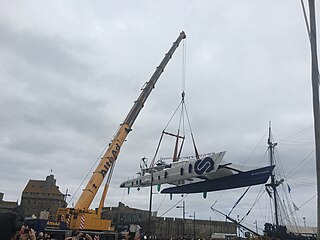
A fuel cell is an electrochemical cell that converts the chemical energy of a fuel and an oxidizing agent into electricity through a pair of redox reactions. Fuel cells are different from most batteries in requiring a continuous source of fuel and oxygen to sustain the chemical reaction, whereas in a battery the chemical energy usually comes from substances that are already present in the battery. Fuel cells can produce electricity continuously for as long as fuel and oxygen are supplied.
A hydrogen vehicle is a vehicle that uses hydrogen fuel for motive power. Hydrogen vehicles include hydrogen-fueled space rockets, as well as ships and aircraft. Power is generated by converting the chemical energy of hydrogen to mechanical energy, either by reacting hydrogen with oxygen in a fuel cell to power electric motors or, less commonly, by burning hydrogen in an internal combustion engine.

USS Triton (SSRN/SSN-586), the only member of her class, was a nuclear powered radar picket submarine in the United States Navy. She had the distinction of being the only Western submarine powered by two nuclear reactors. Triton was the second submarine and the fourth vessel of the United States Navy to be named for the Greek god Triton, At the time of her commissioning in 1959, Triton was the largest, most powerful, and most expensive submarine ever built at $109 million excluding the cost of nuclear fuel and reactors.

A zero-emission vehicle, or ZEV, is a vehicle that does not emit exhaust gas or other pollutants from the onboard source of power. The California definition also adds that this includes under any and all possible operational modes and conditions. This is because under cold-start conditions for example, internal combustion engines tend to produce the maximum amount of pollutants. In a number of countries and states, transport is cited as the main source of Greenhouse gases (GHG) and other pollutants. The desire to reduce this is thus politically strong.
The hydrogen economy is using hydrogen to decarbonize economic sectors which are hard to electrify, essentially, the "hard-to-abate" sectors such as cement, steel, long-haul transport etc. In order to phase out fossil fuels and limit climate change, hydrogen can be created from water using renewable sources such as wind and solar, and its combustion only releases water vapor to the atmosphere.
Hydrogen fuel is a zero-carbon fuel burned with oxygen; provided that it is created in a process that does not involve carbon. It can be used in fuel cells or internal combustion engines. Regarding hydrogen vehicles, hydrogen has begun to be used in commercial fuel cell vehicles such as passenger cars, and has been used in fuel cell buses for many years. It is also used as a fuel for spacecraft propulsion.

A fuel cell vehicle (FCV) or fuel cell electric vehicle (FCEV) is an electric vehicle that uses a fuel cell, sometimes in combination with a small battery or supercapacitor, to power its onboard electric motor. Fuel cells in vehicles generate electricity generally using oxygen from the air and compressed hydrogen. Most fuel cell vehicles are classified as zero-emissions vehicles that emit only water and heat. As compared with internal combustion vehicles, hydrogen vehicles centralize pollutants at the site of the hydrogen production, where hydrogen is typically derived from reformed natural gas. Transporting and storing hydrogen may also create pollutants.

The California Fuel Cell Partnership (CaFCP) is a public-private partnership to promote hydrogen vehicles in California. It is notable as one of the first initiatives for that purpose undertaken in the United States. The challenge is which come first, hydrogen cars or filling stations.

MY Ady Gil was a 78-foot (24 m), wave-piercing trimaran originally created as part of a project to break the world record for circumnavigating the globe in a powerboat. Powered by biodiesel fuel, the vessel was also capable of running on regular diesel fuel. It used other eco-friendly materials such as vegetable oil lubricants, hemp composites, and non-toxic anti-fouling, and had features such as bilge-water filters.

Robert Charles Swan, OBE, FRGS is the first person to walk to both poles.
The Office of Energy Efficiency and Renewable Energy (EERE) is an office within the United States Department of Energy. Formed from other energy agencies after the 1973 energy crisis, EERE is led by the Assistant Secretary of Energy Efficiency and Renewable Energy, who is appointed by the President of the United States and confirmed by the U.S. Senate. Kelly Speakes-Backman was appointed Acting Assistant Secretary in January 2021.
Japan's hydrogen highway is a network of hydrogen filling stations placed along roadsides that provide fuel for hydrogen fuel cell vehicles (HFCV). An HFCV is a vehicle that uses a fuel cell to convert hydrogen energy into electrical energy. The hydrogen that is used in fuel cell vehicles can be made using fossil or renewable resources. The hydrogen highway is necessary for HFCVs to be used. HFCV reduce tailpipe emissions of greenhouse gases. By May 2016, there were approximately 80 hydrogen fueling stations in Japan.

Operation Sandblast was the code name for the first submerged circumnavigation of the world, executed by the United States Navy nuclear-powered radar picket submarine USS Triton (SSRN-586) in 1960 under the command of Captain Edward L. Beach Jr.

MS Tûranor PlanetSolar, known under the project name PlanetSolar, founded by the Swiss explorer Raphaël Domjan, is the largest solar-powered boat in the world and launched on 31 March 2010.

Captain Peter James Bethune is a New Zealand ship's captain with 500 ton master licence, published author, producer of The Operatives TV show, and public speaker. He is the founder of Earthrace Conservation. He works assisting countries in Asia, Central America and Africa with fisheries enforcement and anti-poaching. He is the holder of the world record for circumnavigating the globe in his powerboat Earthrace, a wavepiercing trimaran powered with biofuels.
Alan Priddy is a British power boat sailor and adventurer who has set several boating world records. Priddy attempted to circumnavigate the world in a rigid-hulled inflatable boat (RIB) in 2002, and in 2008 successfully completed a circumnavigation by yacht. He has also navigated a RIB around Scotland, Ireland, Britain and across the Bay of Biscay. He set a world RIB record in 2003 for crossing the Atlantic in 103 hours.

The principle of a fuel cell was discovered by Christian Friedrich Schönbein in 1838, and the first fuel cell was constructed by Sir William Robert Grove in 1839. The fuel cells made at this time were most similar to today's phosphoric acid fuel cells. Most hydrogen fuel cells today are of the proton exchange membrane (PEM) type. A PEM converts the chemical energy released during the electrochemical reaction of hydrogen and oxygen into electrical energy. The Hydrogen Research, Development, and Demonstration Act of 1990 and Energy Policy Act of 1992 were the first national legislative articles that called for large-scale hydrogen demonstration, development, and research programs. A five-year program was conducted that investigated the production of hydrogen from renewable energy sources and the feasibility of existing natural gas pipelines to carry hydrogen. It also called for the research into hydrogen storage systems for electric vehicles and the development of fuel cells suitable to power an electric motor vehicle.

The International Partnership for Hydrogen and Fuel Cells in the Economy (IPHE) is an international collaborative initiative for the development and deployment of hydrogen and fuel cell technologies and to enable global energy security, environmental and economic benefits that these technologies can provide. The IPHE membership is open to national governmental entities that have made significant commitments to invest resources into research, development and demonstration activities to advance hydrogen and fuel cell technologies.

Energy Observer, launched in April 2017, is the first vessel autonomous in energy thanks to a mix of renewable energy and renewable hydrogen produced on board. Developed in collaboration with engineers from the CEA-LITEN the boat will test and prove the efficiency of a full production chain that relies on the coupling of different renewable energies. Following its launch, the boat left in the Spring 2017 for a world tour lasting 6 years in order to optimize its technologies and lead an expedition that will serve durable solutions for energy transition. The boat was nominated first French ambassador of the Sustainable Development Goals by the French Ministry for an ecological and solidary transition.

Navika Sagar Parikrama was a circumnavigation of the globe by female officers of the Indian Navy. The six-member all-woman team circumnavigated and managed the whole operation in their first-ever global journey, on INSV Tarini. The voyage lasted 254 days, from 10 September 2017 to 21 May 2018, with only 4 port calls, in Fremantle, Australia; Lyttelton, New Zealand; Port Stanley, Falkland Islands; and Cape Town, South Africa, and a forced technical halt at Port Louis, Mauritius, crossing the equator twice and passing through 3 oceans. The voyage was originally set to start on September 5, 2017, but a 5-day delay happened so that Nirmala Sitharaman, who was recently appointed defense minister, could flag off the crew. The boat returned to INS Mandovi in Goa after travelling 21,600 nautical miles. The voyage was showcased in Tarini, a documentary jointly produced by National Geographic and the Indian Navy, premiering at an event at Lady Shri Ram College on 8 March to mark International Women's Day. The voyage prompted National Geographic to start the "Girls Who Sailed" campaign, to tell tales of "grit and determination".














